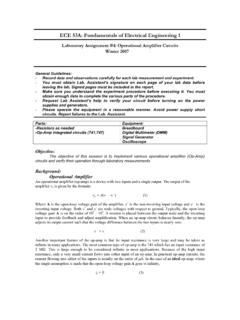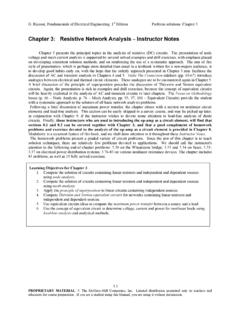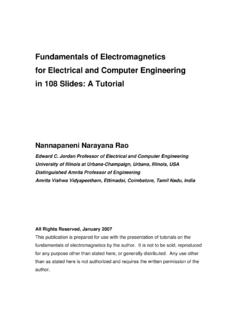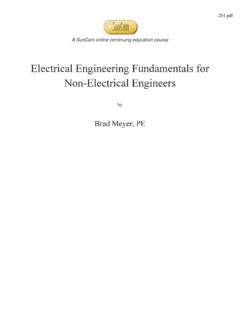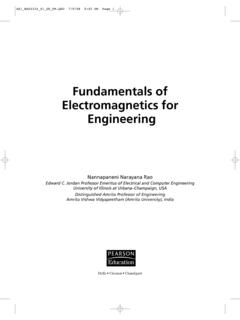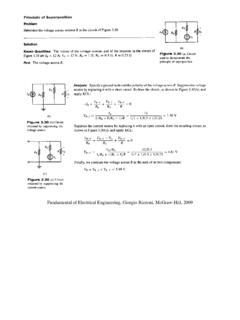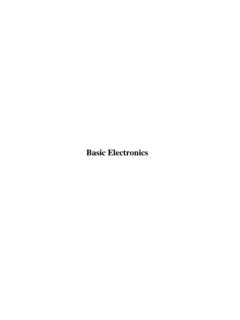Transcription of Fundamentals of Electrical and Computer …
1 Fundamentals of Electrical and Computer engineering Gary A. Ybarra Copyright 2014 by Gary A. Ybarra Version Fundamentals of Electrical and Computer engineering Table of Contents 1. 1 2. Digital Logic 3. Current and 17 4. Elements and 27 5. 41 6. Node Voltage and Branch Current 54 7. Equivalent 8. Capacitance and 84 9. RC Switched 99 10. Complex 110 11. Sinusoids, Phasors and 114 12. Frequency Response and 130 13. AC Circuit 140 14. AC Node and Branch 144 15. Fourier 149 16. Response to a Periodic 160 17. 165 18.
2 RL Switched 171 19. RLC Circuits in the Frequency 180 20. Dependent 193 21. 198 22. Semiconductors, Diodes, and 215 227 Ybarra 1 Chapter 1 Introduction engineering engineering is the acquisition and processing of information to design products and processes that improve human life quality. Science and mathematics are used as tools to solve problems requiring the engineer to consider standards and constraints in the problem solution process.
3 Good engineering design practice takes into consideration many factors such as cost, environmental impact, manufacturability, health and safety, ethics, as well as the social and political impacts of the product or process being created. Science is a systematic approach to the acquisition of knowledge based on testable explanations for phenomena in the universe enabling predictions of event outcomes. Science differs from engineering . Both are important to the process of learning about how the world works, and the exercise of one discipline often involves the other.
4 engineering goes beyond seeking to understand how the world works. Engineers design, build and test devices, systems and processes that involve the creation of something new. There is an inherent process of invention in generating new products and processes that make the lives of humans better and the state of the world better. Some of the inventions of engineers have led to problems in the environment and general state of the planet, but a responsible engineer is committed to considering the environmental impact of his/her products and is bound by ethical principles to produce devices and systems that promote a greener world and a safe environment in which our children are raised.
5 engineering is an exciting and satisfying career and provides an excellent foundation for any career endeavor. Electrical and Computer engineering Electrical and Computer engineering (ECE) is a profession that integrates several sub-disciplines including analog and digital circuits and devices, signal processing, communication systems, Computer architecture and networking, micro and nanodevices, power systems including rotating machines and power distribution, quantum computing, photonics, sensing, waves and metamaterials, required to solve engineering problems to improve human life quality.
6 The list of ECE sub-disciplines presented is not exhaustive, but reflects many of the strengths possessed by the faculty at many universities. It is very unusual to find an ECE program that excels in all areas of ECE, but depending on the expertise of the faculty, the various sub-disciplines of ECE are represented to some degree. Fundamentals of ECE Fundamentals of Electrical and Computer engineering is intended to provide a rigorous introduction to the field of ECE, enabling informed selection of areas of concentration for students planning to continue further study within the field of ECE.
7 It is also an excellent resource for students intending to take the Fundamentals of engineering exam as part of the process for obtaining Professional engineering licensure in a given state. Ybarra 2 engineering Notation It is common in the practice of ECE to encounter both large and small quantities. A set of engineering prefixes have been defined to efficiently deal with large and small quantities. The use of these engineering prefixes is called engineering notation. engineering notation is similar to scientific notation, but the powers of ten are multiples of three.
8 All engineering students should be familiar with the notation of engineering prefixes from 10-15 (femto) to 1015 (Peta). The following table should be common knowledge to all engineering students. engineering Notation engineering Prefix Abbreviated engineering prefix Example usage 10-15 femto f fs 10-12 pico p pF 10-9 nano n nm 10-6 micro 10-3 milli m mW 103 kilo k km 106 mega M M 109 giga G GB 1012 tera T TB 1015 peta P PHz Figure Table of engineering prefixes and their definitions. The notation used in this textbook for voltage and current expresses all time domain quantities with a lower case v for voltage and i for current.
9 Upper case V and I are reserved for sinusoidal (AC) voltage maxima and current maxima respectively. A time domain voltage or current may be explicitly written as a function of time as in v(t) or simply v with the understanding that the voltage may be a constant (DC) or time varying. Plagiarism Every instructor has a different set of expectations regarding what is considered acceptable collaboration. It is the obligation of the instructor to make collaboration expectations known to the students. And it is the students responsibility to follow these expectations.
10 The collaboration policy for ECE 331 is documented in detail. Any questions or comments regarding the collaboration policy are welcome and the reader is encouraged to discuss any issues in question with the instructor. Weekly homework assignments, tests, and a final comprehensive examination will sometimes require students to express their understanding of certain topics in writing. For example, students may be required to learn about batteries and the electrochemical reactions that take place within different batteries. At least two sources are required to be examined and cited properly.
